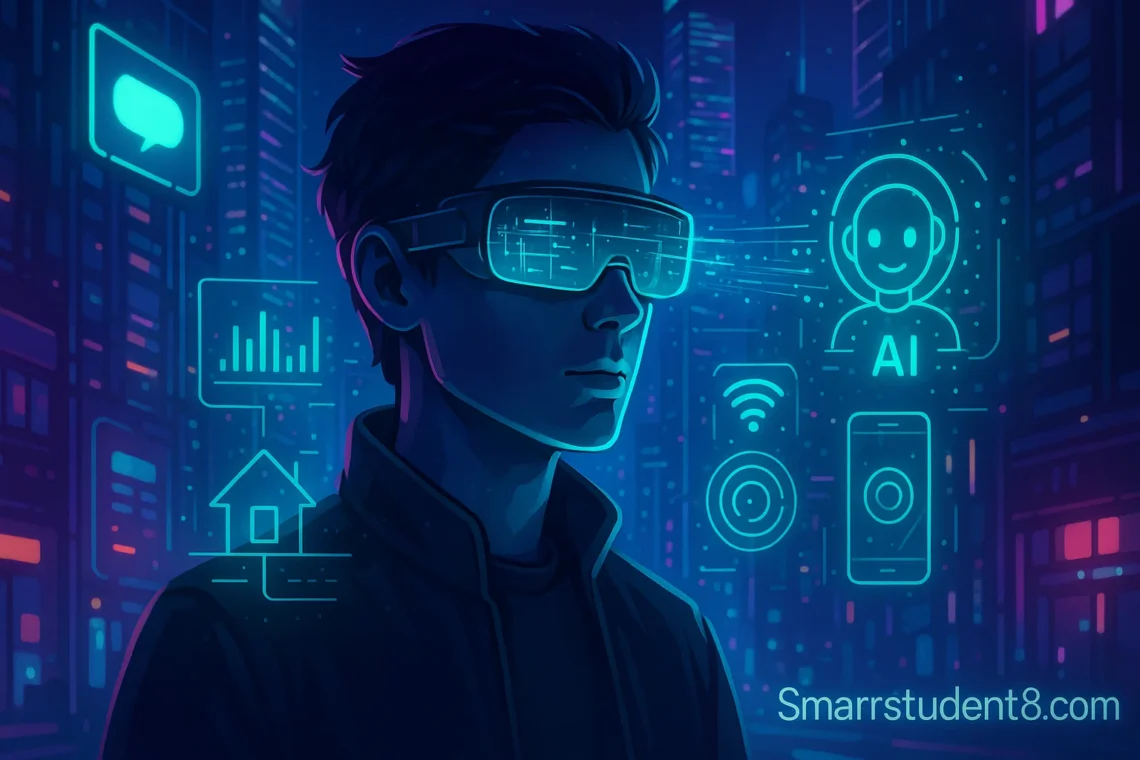The smartphone is the most popular personal device in the world. Our window on the world and our main communication tool is our smartphone. It was a thrilling experience to unbox my first smartphone. I felt as if the future were in my hands. This small rectangular piece of metal and glass replaced my GPS and point-and-shoot camera, as well as my MP3 Player. As we move deeper into the decade, companies that built their empires around this device now spend billions of dollars to render it obsolete. As the quiet buzz of innovation builds to a crescendo,o it signals a massive shift into a post-smartphone age. The tech giants see a world where technology interaction is intuitive, integrated, and less reliant on the screen in our pocket.
The transition to the future is happening right now. The foundational technologies–augmented reality (AR), artificial intelligence (AI), ambient computing, and even brain-computer interfaces (BCIs)–are rapidly maturing. Our devices are moving away from being controlled by us to anticipating our needs. This post explores the visionary ideas of major technology players and the revolutionary technologies that are driving the change. It also looks at what a screenless world might be like for us all.
Smartphone Markets Will Eventually Reach a Plateau
The smartphone is not an exception. Sales figures are still huge, but the growth year over year has been slowing. Innovations have been incremental – a better camera, faster processors, brighter screens. There is a diminishing return, and a new model of phone no longer feels as if it’s a big leap forward but rather a small refinement. As someone who’s been following this industry for many years, I can see the signs that a market is maturing. The investment is moving away from accessories for smartphones and towards next-generation equipment. It’s not because smartphones are failing, but because they’ve been so successful that it is only logical to move on. The tech companies are aware of this plateau, and they’re racing to determine what will come next in order to control the next dominant platform. The strategic shift is driven by the realization that the next trillion dollar opportunity will not come from an improved smartphone but its successor.
The Ambient Computer: Weaving technology into the fabric of reality
Imagine living in a world with technology that is integrated so well into the environment, it’s virtually invisible. Ambient computing promises to deliver on this promise. The environment responds automatically to you and your needs, rather than you having to interact with the device actively. The lighting in your home and office adjusts as you walk from one room to another, while your navigation system will suggest a route based on the real-time data of traffic it has detected. It’s not just smart bulbs and IoT; this is a new paradigm powered by sensors, IoT, and powerful AI. Google is the pioneer of this field and uses its AI expertise to deliver a seamless experience. Project Astra, for example, shows a future in which an AI agent will be able to understand the environment through a camera. It can then respond with contextual questions and act as a constant assistant. It is hoped that this will reduce our cognitive burden of technology management, so we can be present and benefit from its power in the real world.
Augmented Reality Glasses and the Next Visual Interface
AR glasses can be compared to ambient computing, the brainless technology that has replaced smartphones in the world. It is the idea to overlay digital data directly on our field of view, removing the need to look at screens all day. Meta is one of the leading players in this area, investing $50 billion in its Reality Labs Division. Its partnership with Ray-Ban to create smart glasses marked a first important step towards allowing us to wear technology on our faces. Next-generation projects, such as “Hypernova,” aim to combine true AR with holographic display. While the early prototypes of high-end AR devices were clunky and unreliable, I was impressed by the ability to see a 3D object hovering in the center of the room. Apple has also made a big push in its “spatial computer” concept with the Vision Pro. The Vision Pro, although it is not the sleek glasses that we imagine yet, serves as a platform to develop apps and experiences for future hardware. It is a huge challenge to balance processing power, battery, and social acceptance. The goal, however, is to create a phone-like device with the same power as a smartphone but in an easy-to-use form.
AI Companions – The Evolution of the Digital Assistant
Today’s digital assistants, such as Siri or Google Assistant, tend to be reactive. The digital assistants we use today, like Siri and Google Assistant, are largely reactive. Next-generation AI companions will be proactive, contextually aware, and highly personalized. OpenAI, which has been at the forefront of this transition from language models that are powerful to AI agents that can be autonomous, is leading this change. They are developing models for robots and tasks that will help AI to not only answer questions, but also actively assist you in achieving your goals. You could tell an AI assistant to plan a family weekend getaway to the coast. It would take care of everything, from booking accommodation and transport to putting together an itinerary. The evolution of AI requires an in-depth understanding of the context that is unique to each individual, raising privacy issues. The convenience of the technology is an important motivator. Companies are exploring on-device processing to protect personal data while using the cloud for intensive calculations. The hybrid approach may be key in building trust with these digital partners and promoting their adoption.
Brain-Computer Interfaces: The Final Frontier of Interaction
Brain-computer interfaces are perhaps the most sci-fi vision of a future post-smartphone. BCIs, spearheaded by Elon Musk’s Neuralink company, aim to establish a direct connection between the brain and digital devices. Initial applications will be medical in nature, giving hope to people with paralysis who can control a computer or prosthetics by using their minds. This technology has already shown its incredible potential in the first human tests. Researchers in the field have told me that their vision goes beyond just medical applications. In the future, they imagine that thought will be the primary method of input. You would think of a message instead of typing it. You would navigate an interface without a mouse. It is the most effective way to reduce friction between intention and action. The ethical and security implications of this are huge. The device that can read thoughts may also be compromised. The BCI market continues to attract significant investments despite these obstacles, and competitors such as Synchron are developing methods that are less intrusive. Although mass adoption of BCIs is decades away, today’s groundwork could redefine the meaning of being human in an age where technology dominates.
Wearable technology: Beyond the wrist
Wearable tech is a concept that’s already familiar, thanks to smartwatches such as the Apple Watch or Samsung Galaxy Watch. Wearables are expected to become increasingly diverse in the future and integrated with a wider ecosystem. These wearables will be key nodes of the ambient computing system, collecting biometric information and providing feedback through haptics. Smart rings are becoming more popular. They offer a discreet method to monitor health metrics, and can control other devices using gestures. Apple has reportedly been developing its smart ring. This would legitimize this category. AI will power these devices to give you predictive insights into your health, which can alert you before symptoms even appear. Future wearables won’t be satellites for smartphones, but will instead communicate directly with AR glasses, the cloud, and your home. The network of wearables on your body and in your home will form a personal network that constantly works to improve your abilities and wellbeing.
Ecosystems in Battle: Open and Closed Platforms
A new war of platforms will be sparked by the transition to a different computing paradigm, reminiscent of those fought between iOS and Android. Apple is on one side with its closed ecosystem. Apple’s goal is to provide a highly seamless and integrated experience for all of its products, including the iPhone, Watches, Macs, and, eventually, AR glasses. Apple’s walled garden approach encourages user loyalty, and it allows them to maintain control over the experience. This strategy’s strength is flawless integration, but its weakness is a lack of flexibility. Google and Meta are championing a more flexible approach. Google has built an Android platform to support extended reality (XR), in partnership with Samsung and Qualcomm. The strategy is to build a large hardware ecosystem similar to the way Android currently dominates smartphone markets. This strategy can promote competition and choices, but it may also lead to a more fragmented experience. After using both ecosystems for a long time, I can see their merits. Apple’s seamless integration is unquestionable. However, the variety and freedom of Android are appealing. This next platform battle will be won by the company that can best balance the tradeoffs of seamless integration with user choice.
Read More: Use Model XUCVIHKDS number: The Ultimate Guide
The Three Hurdles of Privacy, Social Acceptance, and Power
There are many obstacles in the way of this future. Privacy is perhaps the biggest challenge. A world of sensors, cameras, and microphones that are always on creates the potential for a surveillance nightmare. To earn the trust of users, tech giants need to build strong privacy frameworks that include transparent data governance, on-device computing, and robust privacy policies. Power is another major barrier. Current battery technology is not able to support sleek, lightweight AR sunglasses that can operate all day with a single recharge. Solid-state batteries are essential, as is energy harvesting and wireless charging. The final hurdle is social acceptance. Glasshole, a term coined by Google Glass during its initial launch, to highlight the potential social tension that could arise when wearing a camera in your face. To achieve widespread adoption, designs will have to be discreet, stylish, and not threatening. It is just as crucial to solve these interconnected problems – privacy, power, and social acceptance – as it is to develop the core technology.
One of the biggest technological shifts in recent years is the move beyond smartphones. Today’s technology giants have painted a vision of the future, where technology will be more integrated, intuitive, and personal. We are on our way to a future where technology is more personal, intuitive, and seamlessly integrated into our daily lives. The transition to this new world will take time. This will happen gradually, as new gadgets replace the mirrors in our pockets. We are at a turning point in personal computing, where the future is set to be more spectacular than ever before.
What makes the new age so appealing is that technology will adapt to our needs, not the other way round. We should be aware of the societal and ethical implications associated with powerful technologies like AR, AI, and wearables as they continue to advance. The innovations that are taking form today can not only revolutionize convenience and connectivity but will also promote greater creativity, well-being, and accessibility. While the future of the post-smartphone is not yet clear, the potential for it inspires optimism about how people will work, live, and communicate in the coming years.





